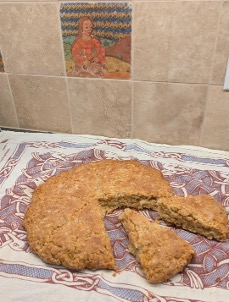Carolyn McDonald Graf
BANNOCK
There are as many types of bannocks as there are recipes for shortbread. Each region has its favorite and each family likes its recipe the best. As Scots moved to other parts of the world, they took their recipes with them. So, it is perhaps not surprising that bannocks eventually found their way into the diets of Indigenous North American tribes.
People have historically made bread from whatever ingredients were available, and the Native North Americans had many types of bread, which they cooked wrapped on sticks over fires and on stones heated in the fire, but none included wheat flour. The influx of Europeans brought many changes to their diet, especially wheat flour. It is believed that bannocks were introduced to the native tribes by Scottish fur traders called Selkirk settlers in the 18th and 19th centuries. Other sources claim that the Navajo learned of bannock bread when they were incarcerated in Fort Sumner in the 1860s.
There is no doubt that the name and the bread bannock became a staple of many native tribes as they were forced onto reservations away from their cultural lands and given government rations of food, including wheat flour, sugar, lard, and butter. The term bannock came to include bread cooked in a pan, oven or on a stick. It often was made with corn flour or plants, instead of wheat flour, but it was still called bannock.
Scottish bannock was originally made with barley, peameal or oatmeal and included wheat flour as that became available to them, changing their recipes, just as the North American natives changed their recipes.
Cape Breton Afternoon Tea Bannock
This recipe charmed me with its story of a recipe carried by generations to different countries. I baked the recipe and was delighted with the result. It was easy to make with the ingredients I had on hand. I hope you like it too.
“At my aunt Annie’s Vermont home it was always time for tea: upon rising, for breakfast, at eleven, in midafternoon, before retiring, and whenever a visitor dropped in. A guest at the doorstep was but another excuse for brewing a fresh pot of that warming beverage so beloved by the Scots. With the cups of strong tea my aunt served her favorite breads, especially this mildly sweet, soft and relatively thick bannock from her Cape Breton homeland.”
Ingredients
2 cups all-purpose flour
1 cup old fashioned rolled oats
1/3 cup light brown sugar
1 Tablespoons baking powder
½ teaspoon baking soda
¾ teaspoon salt
½ cup (one stick) unsalted butter, cold and diced
1 large egg, beaten
2/3 cup buttermilk
2 Tablespoons unsalted butter, melted for topping.
Preheat oven to 400 ⁰ F. Lightly flour the center of a baking sheet.
In a large bowl, combine the flour, oats, sugar, baking powder, baking soda, and salt. With a pastry blender, cut in ½ cup butter until mixture is uniformly crumbly.
In a small bowl, whisk the egg and 2/3 cup buttermilk. Add to dry ingredients, stirring, until well blended to make a soft and moist dough, adding more buttermilk, if needed.
Place in the center of the prepared baking sheet. With floured hands, shape into 10-inch round about ½ inch thick. Bake in preheated oven until evenly browned, and a tester inserted into the center comes out clean, about 18 minutes. Remove to a wire rack. While still warm, brush the top with the melted butter. Serve warm or at room temperature, cut into wedges, with butter and marmalade. Makes one round loaf, 8 to 10 servings.
The Scottish-Irish Pub and Hearth Cookbook, Kay Shaw Nelson, 1999,Hippocrenebooks Inc. New York, New York, P.173.


